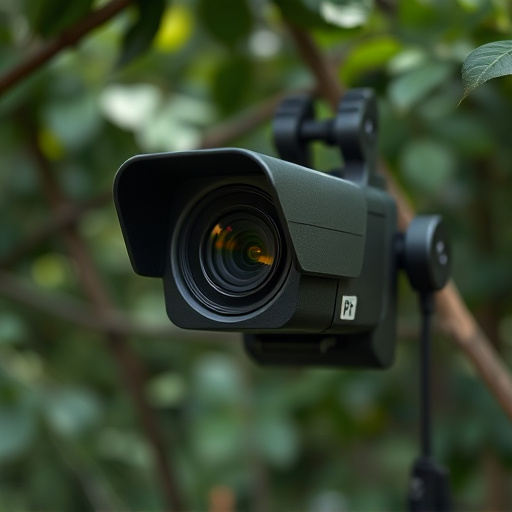Wireless decoy cameras for businesses offer advanced protection by mimicking real surveillance equipment and emitting invisible radiation that can be detected using specialized equipment. These devices, strategically placed throughout a property, enhance security without extensive wiring, providing flexible and integrated solutions. Effective monitoring involves comprehensive signal scanning using RF scanners and analyzers to identify potential threats, while understanding unique signal patterns allows quick responses. Proper positioning, regular testing, and deployment across zones create a robust network that discourages intruders, significantly enhancing business security.
Surveillance technology is evolving rapidly, with electromagnetic (EM) signal-based devices becoming increasingly sophisticated. This article explores the art of detecting hidden surveillance equipment using EM signals, offering valuable insights for businesses aiming to fortify their security measures. We delve into the science behind wireless decoy cameras, a revolutionary tool in countering covert observation. By combining an understanding of EM signals with practical tips and best practices, businesses can enhance their privacy protection and deter potential intruders.
- Understanding Electromagnetic Signals and Their Role in Surveillance
- Wireless Decoy Cameras: A Revolutionary Approach to Business Security
- Tips for Effective Detection of Surveillance Devices Using EM Signals
- Choosing the Right Equipment: Essential Tools for EM Signal Monitoring
- Best Practices for Positioning and Testing Decoy Cameras
Understanding Electromagnetic Signals and Their Role in Surveillance
Electromagnetic signals play a pivotal role in surveillance, often serving as invisible threads that connect various devices and systems. These signals are generated by wireless technologies, including those used in security equipment like decoy cameras. Wireless decoy cameras for businesses, designed to mimic real cameras, emit electromagnetic radiation, which can be detected and analyzed to gather intelligence about potential threats or unauthorized access attempts.
Understanding how these signals behave is crucial for effective surveillance strategies. Electromagnetic waves travel through different mediums, reflecting off objects and surfaces, enabling signal detection at various ranges. By employing specialized equipment that can pick up on these signals, security teams can identify the presence of hidden cameras or other electronic devices, enhancing overall security measures.
Wireless Decoy Cameras: A Revolutionary Approach to Business Security
Wireless decoy cameras are transforming business security by offering a sophisticated and innovative solution to traditional surveillance methods. These advanced devices mimic real camera setups but serve as distractions, luring potential intruders while protecting valuable assets. By strategically placing wireless decoys throughout a property, businesses can create an effective deterrent without the need for extensive wiring or complex installations.
This revolutionary approach provides several advantages. Firstly, it enhances overall security by making it harder for unauthorized individuals to go unnoticed. Secondly, wireless decoy cameras offer flexibility and easy mobility, allowing businesses to reconfigure their surveillance setup as needed. Moreover, these cameras can be integrated with existing security systems, providing a comprehensive and adaptable solution for modern-day safety measures.
Tips for Effective Detection of Surveillance Devices Using EM Signals
The effective detection of surveillance devices using electromagnetic (EM) signals requires a strategic approach, especially in today’s tech-driven landscape where wireless decoy cameras for businesses are becoming increasingly sophisticated. One crucial tip is to implement comprehensive signal scanning and monitoring. This involves utilizing specialized equipment to sweep through various radio frequency bands, identifying any unusual or unauthorized EM emissions that could indicate the presence of hidden cameras or tracking devices. Regular scans can help identify new or previously undetected surveillance equipment, ensuring a proactive security posture.
Additionally, knowing the specific signals emitted by common surveillance devices is essential. Different types of wireless decoy cameras and trackers produce unique signal patterns. By familiarizing yourself with these signatures, you can more accurately pinpoint suspicious activity. This knowledge, combined with continuous monitoring, enables security personnel to quickly respond to potential threats, enhancing overall business security.
Choosing the Right Equipment: Essential Tools for EM Signal Monitoring
Choosing the right equipment is paramount when it comes to monitoring electromagnetic (EM) signals, especially in the context of businesses aiming to protect their premises with wireless decoy cameras. The first step involves understanding your needs; are you primarily concerned with detecting radio frequency (RF) signals from tracking devices or trying to identify potential wireless intrusion? This knowledge will guide your selection of tools like RF scanners and signal analyzers capable of pinpointing specific frequencies.
Invest in high-quality equipment designed for precise EM signal monitoring, such as those offering a wide frequency range and advanced filtering capabilities. Wireless decoy cameras, for instance, should be equipped to mimic real devices while providing accurate data on potential threats. Regular calibration and software updates are essential to ensure these tools remain effective against evolving surveillance technologies.
Best Practices for Positioning and Testing Decoy Cameras
When deploying wireless decoy cameras for businesses, proper positioning is key to effective surveillance. Place these decoys in strategic locations that mimic real camera setups, such as near entry points, parking lots, or areas with high foot traffic. Avoid obvious spots where genuine cameras might be expected, as criminals often look for the easiest targets. Regular testing ensures their effectiveness; set up a routine to verify signal strength and image quality to ensure they’re functioning correctly.
Consider using multiple decoy cameras in different zones to create an elaborate network that discourages potential intruders. Keep them updated with recent technology to match the latest security standards. By following these best practices, businesses can enhance their security posture and deter criminal activities through the strategic use of wireless decoy cameras.
In the ever-evolving landscape of surveillance technology, understanding electromagnetic (EM) signals is key to safeguarding your business. The integration of wireless decoy cameras represents a revolutionary step forward in security measures, offering a subtle yet potent defense against unauthorized observation. By employing effective detection techniques and selecting the appropriate monitoring equipment, businesses can now proactively navigate this modern challenge. With best practices in positioning and testing, organizations can confidently maintain their privacy and security in an increasingly interconnected world, ensuring peace of mind with enhanced surveillance solutions like Wireless Decoy Cameras for Businesses.
